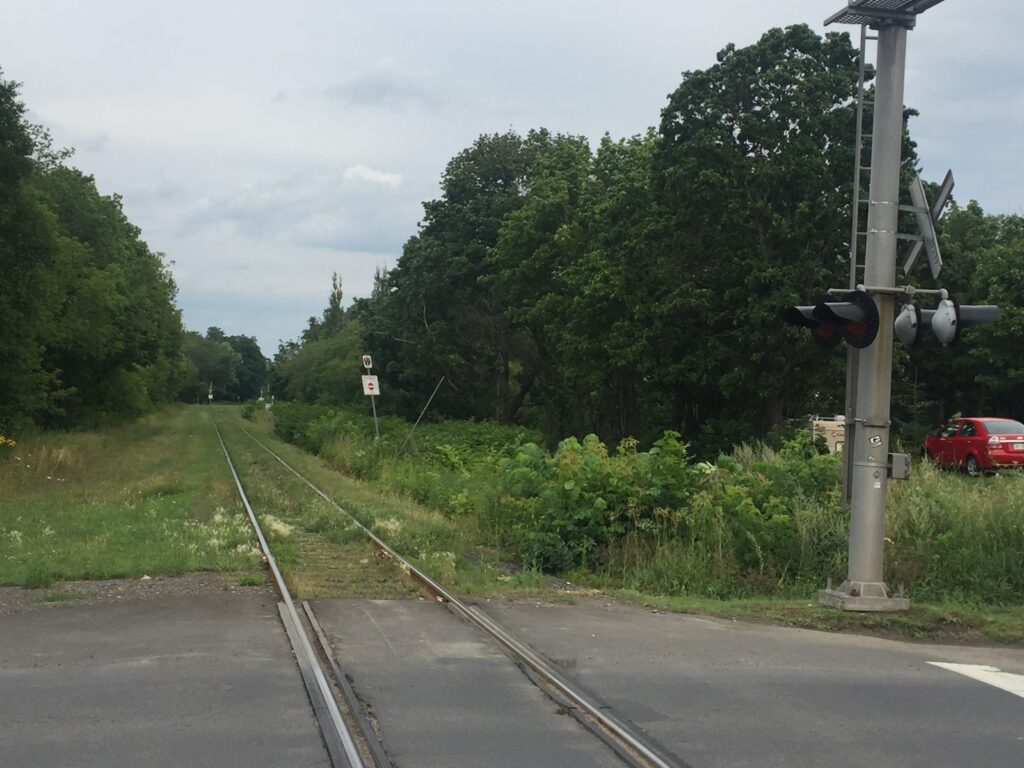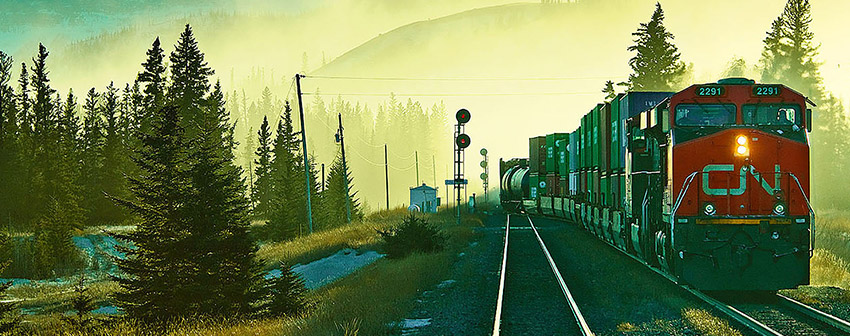Feds confirm Via Rail will replace entire fleet of trains, no clarity on fixing N.B. tracks
Transport minister reiterates modernization plan; transport advocate says tracks should come first
The federal government has confirmed it's pressing ahead with plans to replace Via Rail's entire fleet of trains, but a New Brunswick advocacy group says new tracks are needed in the province first.
Ted Bartlett, former president of Transport Action Atlantic — a public transport advocacy group — said the tracks in New Brunswick are deteriorating.
He attended the federal announcement in Moncton on Thursday afternoon and said he was happy to learn the government was reiterating its commitment to replace the Crown corporation's entire fleet of passenger trains, which date as far back as the 1950s.
However, in an post-announcement interview Bartlett said Transport Canada should start talking to CN Rail to fix the aging tracks in New Brunswick.
 Past
president Ted Bartlett (left), and Tim Hayman, the current president of
Transport Action Atlantic, stand in front of a Via Rail train that
dates back to around the 1950s. (Submitted by Ted Bartlett)
Past
president Ted Bartlett (left), and Tim Hayman, the current president of
Transport Action Atlantic, stand in front of a Via Rail train that
dates back to around the 1950s. (Submitted by Ted Bartlett)
"The snail's pace at which the train must move between Moncton and Campbellton is a national embarrassment, or it certainly should be. We need to fix this and we need to fix it now.
"The newest and shiniest train cars in the world won't attract riders if they have to crawl along at 30 miles an hour," he said.
Federal Minister of Transportation Pablo Rodriguez said his department is aware of the challenges.
He said his department talks with CN "all the time about safety, security, about tracks, about speed, about all kinds of stuff.
"It's a very regulated industry and Transport Canada plays a major role with them. So we speak on a daily basis," he said.
Over 300 train cars and more than 40 locomotives will be replaced across the country's passenger train network, Rodriguez said.
Officials did not say how much the project is expected to cost.
The announcement comes months after the federal government tabled its 2024 budget, which included money for Via Rail to replace its fleet "on routes outside the Québec City-Windsor Corridor," according to a news release from Transport Canada on Thursday.
 Officials announced in late June that new Via Rail train cars had arrived in Windsor. (Jacob Barker/CBC)
Officials announced in late June that new Via Rail train cars had arrived in Windsor. (Jacob Barker/CBC)
Rodriguez would not discuss the state of his department's conversations with CN about New Brunswick's railway tracks, but acknowledged that delays are "a challenge across the country."
Bartlett said the government needs to take leadership on the issue and if they do, the tracks can be fixed in a couple of years.
He said the tracks move very little freight for CN, but for New Brunswickers the delays are "always an uneasy feeling."
"You tend to worry a bit if you're going to make your connection in Montreal," he said.
Rita Toporowski, the chief service delivery officer at Via Rail, said the new fleet will open new on-board service opportunities for the Crown corporation.
 Rita
Toporowski, the chief service delivery officer at Via Rail Canada, says
the new fleet will present new opportunities for on-board service. (Rhythm Rathi/CBC)
Rita
Toporowski, the chief service delivery officer at Via Rail Canada, says
the new fleet will present new opportunities for on-board service. (Rhythm Rathi/CBC)
She said the new fleet will be procured through a global tender bidding process, which could take a lot of time.
"You are talking a lengthy period, you're talking years," she said, citing a complicated negotiation and testing process.
"Our mandate is to serve Canadians right across Canada and we do have lots of communities that are always interested in more service."
Via Rail trip between Halifax, Montreal to take longer due to poor rail conditions
Via Rail says the change will provide passengers 'with a schedule that better represents actual travel times'
Train travellers between Halifax and Montreal will now spend more time on the rails, partly due to a lack of upkeep on the tracks in northern New Brunswick.
Officials with Via Rail say the eastbound Ocean train trip from Montreal to Halifax will take an extra 45 minutes, while the westbound trip from Halifax to Montreal will be 90 minutes longer.
"In response to recurring slow orders imposed by CN, along with a deterioration of operational speeds on that infrastructure due to track conditions, notably on the Newcastle subdivision, Via Rail has no choice but to adjust the schedule of the Ocean, starting June 19, to provide passengers with a schedule that better represents actual travel times," an official said in an emailed statement to CBC News.
The Newcastle subdivision is a 278-kilometre stretch of track owned by CN Rail that runs from central to northern New Brunswick. Via Rail said it gave more than $18 million to CN in 2014 for repairs of a 71-kilometre section of the subdivision between Bathurst and Miramichi.
 Via Rail's Ocean line makes several stops between Halifax and Montreal. (Via Rail)
Via Rail's Ocean line makes several stops between Halifax and Montreal. (Via Rail)
"These funds were spent exceptionally to maintain status quo for passenger rail service levels on the Ocean, as CN was considering the abandonment of that portion of the subdivision," the statement said. "Unfortunately, the current conditions of that same infrastructure have now led to some operational changes."
The poor rail conditions are forcing trains to slow down to about 50 kilometres per hour, according to Transport Action Atlantic, an organization that advocates for the development of and advancement of public transportation in the region. The group also said that 30 years ago, the route had permissible speeds of up to 120 km/h over much of the track.
"It certainly was well travelled because it was a much more frequent service to begin with, but it was also much more reliable and it was a whole lot faster than it is now," said Ted Bartlett, former president of Transport Action Atlantic.
"We're not talking high-speed rail here. We're talking 19 hours and 15 minutes from Halifax to Montreal. But that's a heck of a lot better than it is now."
He said because of the disrepair, trains are forced to "crawl" over some stretches at speeds "no faster than a walk."
According to the Via Rail website, the trip takes an average of more than 23 hours from city to city, with three departures a week. The westbound train from Halifax is scheduled to leave at 11:30 a.m. AT and arrive in Montreal close to 11 a.m. AT the next day. A change in departure time and the lengthened duration makes the trip less appealing to business travellers, Bartlett said. He said 30 years ago, the train left Halifax around 2 p.m. AT and arrived in Montreal the next day around 9:15 a.m. AT, giving travellers more flexibility.
 Ted Bartlett is the former president of Transport Action Atlantic. (Alexandre Silberman/CBC)
Ted Bartlett is the former president of Transport Action Atlantic. (Alexandre Silberman/CBC)
"Really, this is a failure of transportation policy in Canada by successive governments," he said. "We won't blame the current government, its predecessors were just as bad," he said. "They totally ignored passenger rail."
The line itself is not owned by Via Rail, but by CN, a former Crown corporation that was privatized in 1995. In Bartlett's estimation, the lack of investment into passenger rail is about "shareholder value."
"And there's no shareholder value in investing in a track that's as lightly used as the Newcastle subdivision. So CN isn't going to do anything about it."
When asked about the condition of the tracks in the subdivision, CN spokesperson Ashley Michnowski said in an email that the corporation's ongoing maintenance of the area "will allow for some improvement to speed restrictions in the coming weeks and months."
Michnowski said CN invested roughly $22 million last year in maintenance to more than 950 kilometres of track in New Brunswick, including the Newcastle subdivision, and it carries out regular maintenance on its network "to the extent it is commercially reasonable."
Expert says passenger rail needs support from government
Gordon Lovegrove said that more investment in train travel in Canada could be a boon financially and environmentally.
"There's a really good business case for passenger rail in Canada, given we need to take some urgent drastic action to reduce the amount of emissions into the climate, into the atmosphere," he said.
Lovegrove, an associate professor in the School of Engineering at the University of British Columbia, said while passenger rail isn't a "panacea" for travel issues, it does offer some affordable and safe solutions.
Like Bartlett, Lovegrove said because most railway companies in the country are privately owned, they tend to be motivated by the bottom line.
"Transportation is a social determinant of health, and private, profit-motivated companies are looking at direct costs and benefits to themselves and nobody else, not the general public," Lovegrove said.
"I think the government has to step in and say, 'Listen, are we doing this? Are we getting on board the national and international and provincial climate action bandwagon or are we not doing this?'"
Another setback for VIA Rail’s Ocean
There’s been yet another blow to the last remnant of passenger rail service in the Maritimes. VIA Rail has announced a schedule change effective June 19 that officially adds 90 minutes to the travel time of the Ocean between Halifax and Montreal. The adjustment is being made to compensate for badly deteriorated track conditions on CN’s Newcastle Subdivision in northern New Brunswick.
“VIA is simply recognizing the reality that the speed restrictions imposed by CN make it impossible for the Ocean to maintain its currently published schedule,” says Transport Action Atlantic president Tim Hayman. “As a result, connections to Toronto, Ottawa, and other points west of Montreal have become less reliable. For passengers heading east, it is a frequent occurrence for the train to be running between two and three hours late, and this lack of reliability is clearly unacceptable.
“Unfortunately VIA apparently has no other choice but to pad and adjust its schedule. There is no indication of any plans by the infrastructure owner to restore the track to its previous standards. The result is a total journey time far longer than any in recent memory – more than 23 hours from Halifax to Montreal. This is most certainly not consistent with VIA’s recently-announced strategy of improving passenger rail for all Canadians.”
Effective June 19, the Ocean will be departing Halifax at 1130, instead of 1300 as has been the case in recent years. The extra 90 minutes in the schedule is expected to make connections at Montreal more reliable and allow the eastbound train to maintain its schedule by retiming the overnight meet between the two trains, but will not address the root cause of the problem.
 A
look at overgrown track on a section of the Newcastle Subdivision near
Campbellton NB several years ago. Ongoing neglect of this line and
ensuing slow orders have forced this latest lengthening of the Ocean’s
schedule. PHOTO – Ted Bartlett
A
look at overgrown track on a section of the Newcastle Subdivision near
Campbellton NB several years ago. Ongoing neglect of this line and
ensuing slow orders have forced this latest lengthening of the Ocean’s
schedule. PHOTO – Ted Bartlett
“This is yet another example of how transportation policy of successive federal governments is failing Canadians,” says TAA past president Ted Bartlett. “It will now take nearly five hours longer to travel from Halifax to Montreal than it did 30 years ago. And while we are encouraged to see that Ottawa’s recent budget is making provision to begin replacing the aging fleet of long-haul passenger cars and locomotives, this by itself is not sufficient. There are serious infrastructure issues that must also be addressed, because new equipment will still be subject to the same speed restrictions on this deteriorated track. Frankly, this situation is a national embarrassment.”
Under the revised timetable, the westbound Ocean will require 6 hours and 16 minutes to travel the 186 miles (300 km) of mostly sub-standard track from Moncton to Campbellton – an average speed of less than 30 miles per hour. (In keeping with standard North American railroad practice, track distance and speeds continue to be stated in miles.) Thirty years ago the route was covered in just over four hours, with permissible speeds of up to 75 mph over much of the trackage. A lack of maintenance over the years has resulted in steady deterioration and numerous speed restrictions to ensure safe operation.
“Transport Action Atlantic believes there are three key pillars to ensuring a healthy future for what remains of passenger rail in our region,” says Tim Hayman. “VIA Rail urgently needs new locomotives and cars to replace its old and outdated equipment; there must be investment to restore the track infrastructure to the reasonable standards it once maintained; and the service must operate daily with faster and reliable schedules that meet or exceed those that the Ocean was historically known for.”
 Tim
Hayman (r.) and Ted Bartlett stand beside VIA’s Ocean on the Moncton
station platform on April 29, 2024. The 78-year-old coach behind them is
among the oldest in VIA’s fleet, having been built for the New York
Central Railroad in 1946.
Tim
Hayman (r.) and Ted Bartlett stand beside VIA’s Ocean on the Moncton
station platform on April 29, 2024. The 78-year-old coach behind them is
among the oldest in VIA’s fleet, having been built for the New York
Central Railroad in 1946.
Here is the revised (and lengthened) schedule for trains 14 and 15, effective June 19, 2024:
For reference and nostalgia, here’s a look back at the VIA timetable from 30 years ago – effective 24 April 1994 – showing the Ocean departure from Halifax at 1400 and arrival in Montreal at 0815, for a total running time 19 hours, 15 minutes. We’re a far cry from that today, not to mention the absence of the other trains on this timetable!
TAA past president Ted Bartlett was on the Todd Veinotte show on June 4th to talk about this schedule change. You can listen to his interview, beginning at the 10:04 minute mark here: https://halifax.citynews.ca/2024/06/04/the-todd-veinotte-show-june-4th-10am/
The Bulletin is published twice a year by Transport Action Atlantic
Box 268, Dartmouth NS B2Y 3Y3 atlantic@transportaction.ca
Editorial Committee: Don MacLeod, Tim Hayman and Ted Bartlett
TAA Executive
Ted Bartlett President Moncton NB (506) 386-3615
Tim Hayman Vice-president /webmaster Halifax NS (902) 818-9948
Donald MacLeod Treasurer Halifax NS (902) 876-7960
Michael Perry Secretary Fredericton NB (506) 459-7330
Christine Mills Garnet Membership Secretary Dartmouth NS (902) 405-3714
Board Members
Ashley Morton Halifax NS Marcus Garnet Dartmouth NS
Allan MacDonald Antigonish NS Tom Beckett St. John’s NL
Stan Choptiany Saint Andrews NB John Cormier Charlottetown PEI
Special Advisors Howard Easton, Moncton NB; Yves Bourgeois, Shippagan NB; and
David Gunn, West Bay NS
www.transportactionatlantic.ca
The Americanization of CN
The CN Rail Strike
It is day 16 of the strike at Symington Yard, the Canadian National Railway’s main hump yard in Winnipeg. It is a cold, gray, and dank day. The wind is blowing. The sound of cars from the nearby street swishes by. The workers talk amongst themselves. Strapped to the outside of their bulky winter coats are signs with the word “STRIKE” printed boldly in large letters. Sympathetic cars passing by honk their horns, and the workers nearest the street raise their hands in response to the expressions of solidarity.
Guy Bouvier, a CN employee walking the picket line, peers from the shell of his winter coat. Even though the sun is nowhere to be seen, he wears a pair of fluorescent sunglasses that would not be out of place on a ski hill.
“I hired on in ’81. There were approximately 76,000 people working at that time. In 1967 there were about 125,000 people. Right now we’re down to eighteen-five,” says Bouvier.
Behind him, a group of his fellow workers and members of the Canadian Auto Workers union (CAW) huddle by a burning barrel located on the perimeter of the yard. A couple of them throw pieces of scrap lumber into it. Sparks fly up, but are quickly blown out by the brisk, chill Manitoba wind. Nearby, a City of Winnipeg police caravan sits silently, watching over the entrance to Symington Yard like a bulbous metal spider.
The workers have been on strike since February 20, when an initial offer from CN was scrapped. But since a deal has by now been reached, the question is why CN rail workers from Winnipeg to Montréal felt it was time to send a message to CN’s corporate headquarters.
The Privatization of the CNR
Canadian National was born out of a series of smaller rail lines that, after running out of funds, were then bought by Robert Borden’s Conservative government back in 1918. The political machinations and motivations behind the nationalization of the Canadian railways were complex. Aside from rescuing the banks–the creditors of the bankrupt rail companies–a government-owned national railway system would be better able to provide cheaper rates for businesses that wanted to distribute their goods as efficiently as possible than would a privately-owned monopoly–which was the threat that the Montréal-based Canadian Pacific Railway posed to the Toronto business community at the time. After the dust settled and the Canadian government put its stamp on all the rail lines in Canada–over 22,000 miles of track and 100,000 employees–CN had became one of the world’s largest railroads.
“To put it in a historical perspective, CN was the flagship, premier Crown corporation of this country,” says Robert Bourrier, a CAW system health-and-safety legislative representative and CN history buff. “Out of it came TCA [TransCanada Air Lines, the forerunner of Air Canada] and the CBC.”
CN, however, almost always operated in the red, and it was rare that it showed a profit. In the late 1970s, the federal government forgave CN’s loans, which allowed the company to show a modest profit. But by the eighties, with increasing competition from other railroad companies and the trucking industry, there was a movement by some in the federal government to make CN more competitive. Many believe that these moves were taken as the first steps in the eventual privatization of CN.
“In the late eighties there was a big move to deregulate the railway industry under such banners as ‘Freedom to Move,’ ” Bourrier explains. The Railway Safety Act was gutted and other legislative steps were taken to deregulate the railroad industry and bring it ostensibly more in line with the relatively few safety regulations governing the trucking industry. The current rules governing safety are “company-written,” states Bourrier. “[They] were presented by the Railway Association of Canada … the railway companies basically re-wrote the rules,” allowing them “the flexibility to do what they want.”
CN underwent a massive structural change, as well. It divested itself of many of its other businesses, like the Toronto’s CN Tower, in order ostensibly to concentrate fully on the railroad business and to reduce its debt. Advisors also believed CN had overcapacity in certain rail lines that were underutilized and, thus, uncompetitive. This belief led to the closure of rail lines in rural areas, once the sole raison d’être of many a small town. Thousands of miles of rural track were ripped up, leaving nothing but beds of gravel to show where there were once rail lines.
“You have CN shedding those lines that historically were built to service our Canada … and having them spun off into short-line operations … or shut down altogether,” says Bourrier.
The move to make CN competitive eventually led to the conclusion that it would be best if CN were privatized. This was foreshadowed when Paul M. Tellier, a top-level Liberal bureaucrat, became CN’s president and CEO in 1992. “[Tellier’s] mandate, in my opinion, was to privatize CN,” states Bourrier.
Actual privatization happened in 1995, when the federal Liberal government made CN a publicly traded company. “They figured out an approximate value and … sold [CN] off,” says Derek Black, a retired machinist with a 30-year history at the company.
CN’s website claims that the privatization of CN “was the largest and most successful privatization in Canadian history,” selling all the offered shares within a single day, pouring $2.2 billion into the federal government’s coffers.
Canadian in Name Only?
Around the same time as the privatization of CN, according to Black, laws governing the percentage of foreign ownership changed, allowing for greater foreign investment in Canadian companies.
“The end result was that you had more and more shares ending up in American hands,” Black comments. He estimates that the percentage of American and foreign ownership of CN shares is now between 80 and 90 per cent. “It’s a publicly traded company,” adds CAW national representative Doug Olshewski. “But 80 per cent of the stock is held by Americans.”
CN’s next move was interesting: It purchased Illinois Central, a major American railroad company. Illinois Central is based out of Chicago and runs south to New Orleans. But whether CN really purchased Illinois Central, or if it was the other way around, remains an open question.
The Illinois Central purchase of was just the first manifestation of CN’s newfound thirst for acquisitions. It went on a buying spree, snapping up smaller, class-2 American railroad companies, like Wisconsin Central. The goal was to increase CN’s distribution control over North America by having connections to the three coasts: east, west, south. Black maintains that more was happening at CN than just these acquisitions: there was a re-calibration of management as well. “In order to cement these mergers and purchases, they began a process of integrating the management,” he explains. Tellier was still CEO at the time of the Illinois Central purchase; but the merger with Illinois Central was accompanied by the arrival of E. Hunter Harrison, president and CEO of Illinois Central, who then became Tellier’s number two man. In 2003, Harrison became the chief. Since then, there appear to have been more and more Americans in senior management positions.
In other words, CN was fast losing any connection to its Canadian roots. On the day of CN’s privatization, Black organized a New Orleans-style funeral for CN: a perhaps perverse but fitting American funeral for the demise of a Canadian institution.
Business American-Style
CN soon started changing its business practices drastically in order to cut costs and boost profits.
“Once it was privatized and out of the control of the federal government, [CN] began a very aggressive campaign of contracting the repair and maintenance work out and shipping it south of the border to little shops and plants in the United States,” Black says. “All of a sudden you find the work disappearing, and you’d have a tough time figuring out where the work had gone.”
Black and his fellow workers also noticed another, sleazier change in CN’s corporate attitude. “They became much more sophisticated in some of the wheeling and dealing going on. There were rules and regulations under the collective agreements that forbade the contractingout of work. [CN] began to, quote-unquote, “scrap” locomotives, and they would sell them to an American firm. The American firm would then move them into Montreal … into a former CN shop. There [the locomotives] would be totally re-built, shipped back to the American firm, and then leased back to Canadian railways.”
Black then chooses his words carefully: “That’s what I would refer to as a really ‘sharp’ practice.”
Black believes that, to those pushing the privatization process, the attraction of privatization itself was more important than looking at the actual costs and value of keeping CN public. “The quality [of repair work by Americans] doesn’t stand up, the price doesn’t stand up. If it was costing $1,000 to do a job in the shop here, then it was costing them $2,000 to get [the job] done in the States.” In other words, saving money wasn’t the point of privatizing CN.
Another questionable business practice on CN’s part happened during the strike, when scab workers were imported from the U.S. to fill Canadian workers’ positions when the latter went on strike. According to Bill Blaikie, Member of Parliament for Transcona, historically a railway workers’ community, this violates a NAFTA provision under which no company is allowed to transfer workers from one country to another. “The [federal] government refused to do anything about it because it said this was an intra-company transfer,” says Blaikie. The federal government, he argues, was “hiding behind NAFTA. But, in fact, there were provisions in NAFTA , if the government were willing to use them … about not being able to bring workers in for the purpose of getting involved in a labour dispute.”
American-Style Management
Many CN workers believe that with the Americanization of CN came a different, more aggressive attitude to the treatment of workers. “They come from a different culture in the United States in terms of labour relations … in terms of their political [and] social views,” Bourrier explains. He describes the American managers at CN as “ruthless” by Canadian standards. “They have very little regard for Canadian rules. Whatever [rules] don’t suit them, they will try to change them.”
In addition to actively lobbying the Canadian government to change labour laws in its favour, CN has instituted some eyebrow- raising labour changes for the workers of CN themselves. First came an increased workload, which CN workers now must bear owing to the technological advances in the railroad industry and an increased need to maximize profits by lowering costs.
“What we found was that there was so much anger towards the employer that a strike was inevitable,” Olshewski says. “The company’s prime objective was to have the best operating ratio in North America … which means for every 66 cents they spend they earn a dollar. And that meant huge rationalization, speed-ups, productivity gains–all on the backs of the workers.”
Another workers’ grievance related to workplace injury. The old system was a nofault system, and the former CN management treated injuries within that context. In the U.S. system, with its emphasis on personal responsibility and its penchant for lawsuits, the employer is responsible for the workplace. Since it is in the best interest of management to avoid lawsuits, the American management imported the American method of dealing with injuries. Olshewski says the management has no sympathy: “If you get in an accident, it’s your fault.” The unfortunate result is that workers, given the choice between reporting an injury or getting suspended, tend not to report.
But the change in management style that has angered CN workers most involves the issue of discipline. Many CN workers believe they are not respected by CN management, one of the main reasons they voted down an initial contract offer between CN and their union representatives. The fact that their union recommended approval of the offer caused some anger among workers who questioned the union’s commitment.
“We have had a disciplinary policy that has been in effect for a hundred years called the Brown system of discipline, which means you get demerit marks for punishment,” says Olshewski. He says the new management didn’t want to keep the Brown system. “They said it was too hard to fire people under that system …they wanted to change arbitration procedure.”
Bourrier seems to agree that the new CN management took a harder line on discipline, adding that management “was giving suspension for very, very slight infractions.”
“It’s the way people are being treated, the lack of dignity shown to the workers, that has become a real big issue here,” Olshewski says.
Perhaps icing on the cake, Black claims he has heard American managers giving derisive slurs to Canadian CN employees, including names like “snow niggers” and “overpaid Mexicans.”
In the End
The strike has ended some time ago. According to the union’s interpretation of what was agreed to, it was a major victory for the workers, with favourable resolutions on safety and discipline issues. Others, like Hunter Harrison, took away a different understanding. The final outcome is still unclear.
STRIKE CHRONOLOGY
Dec. 31, 2002: the contract for CAW shop-craft, intermodal and clerical workers expires
Feb. 20, 2004: Nearly 5,000 CAW shop-craft, intermodal and clerical workers go on strike after rejecting a proposed contract. The contract would have provided wage and benefit increases of 9.7 per cent over three years. Union leaders recommended acceptance of the offer. The underlying reason for union members rejecting the initial offer from CN was mainly related to the issue of CN’s American-style discipline system.
March 15, 2004: CAW agrees to a tentative deal to end the strike. The deal provides for a return-to-work bonus of $1,000 and annual salary increases of three per cent. CN also agrees to drop a new disciplinary system and go back to the one that was in place before Jan. 1, 2001.
April 12, 2004: A hostile and intimidating environment with new restrictions on flextime, more contracting out of work and threats of large permanent layoffs greeted workers when they returned to their workplaces. “The company is seeking revenge for what in their view was a costly strike,” says Rick Johnson, president of National Council 4000. A bad faith bargaining complaint against CN was being contemplated at the time of this writing.
Eric Warwaruk was born and raised on a family farm in midwestern Manitoba. He has a degree in film studies from the University of Manitoba, and is completing his M.A. thesis in communications studies at McGill University in Montreal. He currently works as a freelance writer in Winnipeg
This article appeared in the May/June 2004 issue of Canadian Dimension .
Rail

Rail
We Connect the Dots
We got our start in rail close to 100 years ago. Since then, we’ve evolved into a world-class transportation leader and the only transcontinental railway in North America. Our 20,000-mile network spans Canada and Mid-America, connecting three coasts: the Atlantic, the Pacific and the Gulf of Mexico. Our supply chain partnerships carry customer cargo all the way to Mexico City. Wherever you find CN trains, you’ll find a host of service options to help you ship more; faster, further and more cost-effectively.
The Board has oversight responsibility for the stewardship of CN and its business and is accountable to shareholders for the performance of CN. The Board has clearly delineated its role and the role of management. The role of the Board is to supervise the management of CN’s business and affairs, with the objective of creating value for shareholders and taking into account the interests of other stakeholders. Management’s role is to conduct the day-to-day operations in a way that will meet this objective.
Among its activities that derive from its stewardship and decision-making responsibilities, the Board has oversight responsibilities over:
- Strategic Planning
- Executives
- Corporate Governance
- Risk Management, Financial Reporting and Internal Controls
- Capital Allocation
- Sustainability, Environment, Safety and Security
- Pension Fund Matters
For more detailed information on these responsibilities, refer to the Management Information Circular.
 JO-ANN dePASS OLSOVSKY
JO-ANN dePASS OLSOVSKYCorporate Director. Retired Executive Vice-President and Chief Information Officer, Salesforce.com, Inc.
 DAVID FREEMAN
DAVID FREEMANCorporate Director. Retired Executive Vice-President of Operations, BNSF Railway
 DENISE GRAY
DENISE GRAYCorporate Director. Retired Director External Affairs & Government Relations, North America, LG Energy Solution Michigan Inc., U.S.
 JUSTIN M. HOWELL
JUSTIN M. HOWELLSenior Investment Manager, Cascade Asset Management Co.
 SUSAN C. JONES
SUSAN C. JONESCorporate Director. Retired Executive Vice President and Chief Executive Officer of the Potash Business Unit at Nutrien Ltd.
 ROBERT KNIGHT
ROBERT KNIGHTCorporate Director. Retired Chief Financial Officer, Union Pacific Corporation
 MICHEL LETELLIER
MICHEL LETELLIERPresident and Chief Executive Officer, Innergex Renewable Energy Inc.
 MARGARET A. McKENZIE
MARGARET A. McKENZIECorporate Director. Former Chief Financial Officer of Range Royalty Management Ltd.
 AL MONACO
AL MONACOCorporate Director. Retired President and Chief Executive Officer, Enbridge Inc.










